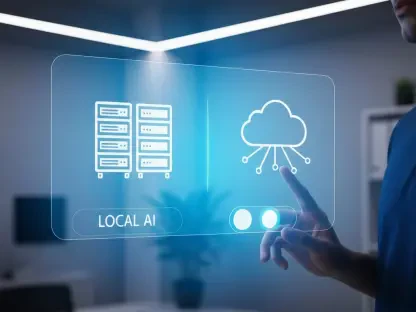In an era where technology evolves at breakneck speed, Coinbase, a prominent cryptocurrency exchange, is setting a groundbreaking precedent by aiming to have more than half of its code generated by artificial intelligence (AI) by October. This ambitious target is not merely a corporate milestone but a reflection of a profound transformation sweeping through the tech industry, where AI is becoming an indispensable ally in software development. Already, 40% of the company’s daily code is crafted through AI tools, positioning Coinbase as a trailblazer in a movement that promises to redefine efficiency and innovation. This shift raises compelling questions about the future of coding, the balance between automation and human oversight, and how such advancements might reshape the competitive landscape. As Coinbase pushes the boundaries of what’s possible, its journey offers a glimpse into a world where machine-driven solutions could dominate, challenging traditional notions of creativity and productivity in tech.
Driving Innovation Through AI Integration
The drive toward AI dominance in coding at Coinbase is spearheaded by CEO Brian Armstrong, whose unwavering commitment has made the adoption of tools like GitHub Copilot and Cursor mandatory for the company’s 1,500 engineers. This isn’t a casual experiment but a strategic overhaul, with strict enforcement measures in place—non-compliance has even led to employee dismissals. Beyond just mandating usage, Coinbase fosters a culture of innovation through monthly “AI speedruns,” events designed to demonstrate practical applications of AI in real-world scenarios. Progress is meticulously tracked using key performance indicators such as lead-time-to-change and deployment frequency, ensuring that the integration of AI translates into tangible benefits. This structured approach highlights a deliberate effort to not only embrace cutting-edge technology but also to optimize its impact across development cycles, setting a standard for how AI can be woven into the fabric of a tech enterprise.
Complementing this rigorous framework is Coinbase’s focus on embedding AI as a core component of its operational ethos. Rather than treating AI as a peripheral tool, the company views it as a fundamental driver of future growth, capable of accelerating development timelines and reducing human error in repetitive tasks. This perspective is evident in the way engineers are onboarded with comprehensive training to leverage AI effectively, ensuring that the technology is not just adopted but mastered. The emphasis on continuous learning and adaptation reflects an understanding that the potential of AI extends beyond immediate productivity gains—it’s about building a workforce equipped to navigate an increasingly automated landscape. As Coinbase refines its processes, the broader implication is clear: AI isn’t just reshaping how code is written; it’s redefining the very nature of technical expertise in the industry.
Reflecting a Broader Industry Shift
Coinbase’s pursuit of majority AI-generated code mirrors a sweeping trend among tech giants, signaling that this is far from an isolated endeavor. Companies like Google, which already boasts over 25% AI-generated code, and Microsoft, at 30% with projections to reach 50% within two years, are equally invested in this transformative wave. On a global scale, the economic impact is staggering, with a recent study estimating that AI-driven coding contributes $10-14 billion annually to the U.S. economy alone. Developer surveys further underscore this momentum, revealing that 84% of programmers are either using or planning to adopt AI tools in their workflows. These figures paint a picture of an industry at a turning point, where reliance on AI is no longer optional but a competitive necessity, pushing companies to rethink traditional development models in favor of automated solutions.
Beyond corporate boardrooms, the global implications of this shift are profound, as AI adoption in coding reflects varying levels of technological maturity across regions. While advanced economies lead the charge, with significant portions of codebases now machine-generated, the benefits are not universally accessible, creating disparities that could influence economic competitiveness. This trend also raises questions about the future of innovation—will AI standardize coding practices, or will it enable greater creativity by freeing developers from mundane tasks? For Coinbase, aligning with this industry-wide movement isn’t just about keeping pace; it’s about positioning itself as a leader in a landscape where efficiency and speed are paramount. The convergence of corporate strategies and global data suggests that AI’s role in software development will only deepen, reshaping not just how tech operates but also how value is created on an international scale.
Navigating the Balance of Speed and Security
While the allure of AI-driven efficiency is undeniable, Coinbase is keenly aware of the need to temper enthusiasm with caution, particularly when it comes to sensitive systems. Not all areas of development are suitable for AI-generated code due to potential security vulnerabilities and the risk of compromised quality. To address this, the company employs a robust developer productivity framework grounded in DORA metrics and regular feedback surveys, ensuring that AI integration is both responsible and sustainable. Rigorous code review processes remain a cornerstone of this approach, acting as a safeguard against errors that automated systems might introduce. This measured strategy reflects a broader industry concern: while AI can accelerate output, maintaining high standards of reliability and safety is non-negotiable, especially in sectors handling critical data.
This cautious stance is not unique to Coinbase but echoes a shared priority among tech leaders who recognize that unchecked reliance on AI could lead to significant pitfalls. The balance between leveraging automation for speed and preserving the integrity of complex systems is a delicate one, requiring constant vigilance and adaptation. For instance, while AI excels at generating boilerplate code or optimizing routine functions, human oversight is indispensable for nuanced decision-making and addressing edge cases that algorithms might overlook. Coinbase’s commitment to blending AI capabilities with stringent quality controls serves as a model for how companies can harness technological advancements without sacrificing trust or security. As this balance is refined, it becomes a critical factor in determining whether AI will be seen as a reliable partner or a risky shortcut in the evolution of software development.
Developer Dynamics in an AI Era
At the ground level, the impact of AI on developers is reshaping daily workflows in ways that are both empowering and challenging. A significant portion of programmers—over 40% according to recent surveys—report that half of their codebase is now AI-generated, a statistic that underscores how deeply embedded this technology has become in routine tasks. This shift allows developers to focus on higher-level problem-solving and creative aspects of their work, as AI handles repetitive coding elements with speed and precision. The synergy between corporate mandates, like those at Coinbase, and grassroots adoption among individual coders is driving a cultural transformation, where embracing AI is increasingly seen as a hallmark of modern technical proficiency.
However, this transition is not without its complexities, as developer perspectives on AI vary widely across the industry. While many view it as a game-changer that enhances productivity and reduces burnout, others caution against over-reliance, pointing to risks such as subtle bugs or security flaws that automated code might introduce. The need for robust oversight and continuous training is a recurring theme, as developers adapt to a landscape where their role evolves from sole creators to collaborators with intelligent systems. Coinbase’s experience reflects this duality—its engineers are encouraged to innovate with AI while remaining vigilant about its limitations. This dynamic highlights a critical truth: the success of AI in coding depends not just on technology but on the human capacity to guide and refine its application, ensuring that progress does not come at the expense of quality or trust.
Global Disparities and Forward-Looking Challenges
The rapid adoption of AI in coding reveals stark disparities across the global tech landscape, with advanced economies like the U.S., Germany, and France reaping substantial benefits while others struggle to keep up. This uneven distribution threatens to widen the digital divide, as regions with limited access to AI tools or infrastructure risk falling behind in technological and economic competitiveness. Coinbase’s aggressive push toward its October target serves as a microcosm of this broader challenge, illustrating how innovation in one sphere can inadvertently exacerbate inequalities elsewhere. Addressing this gap will require concerted efforts to democratize access to AI technologies, ensuring that the transformative potential of automated coding is not confined to a select few.
Looking ahead, the challenges extend beyond access to the very nature of integrating AI responsibly on a global scale. As Coinbase nears its ambitious goal, the tech community watches closely, recognizing that the balance between innovation and accountability will define the legacy of this shift. The focus shifts to crafting frameworks that can scale AI adoption without compromising critical standards, a task that demands collaboration across industries and borders. Solutions emerge in the form of shared best practices and investments in education to equip diverse workforces with necessary skills. The journey underscores a pivotal lesson: while AI holds the power to revolutionize software development, its true value lies in how inclusively and thoughtfully it is applied, shaping a future where technology serves as a unifying force rather than a divisive one.









